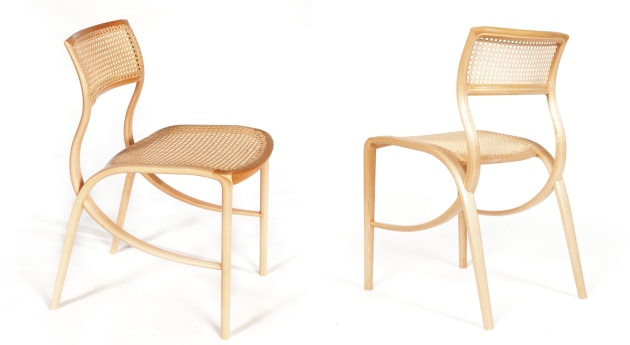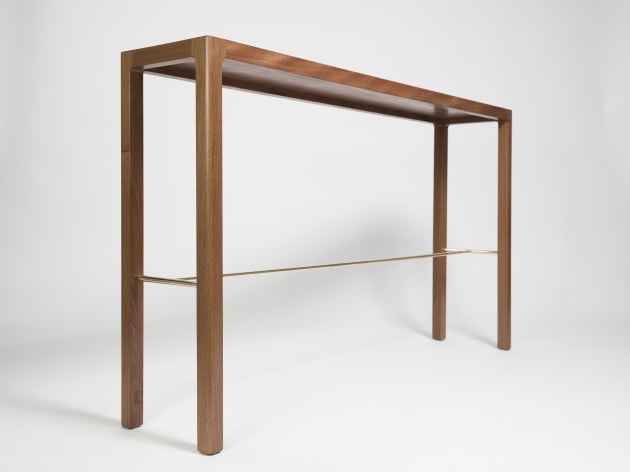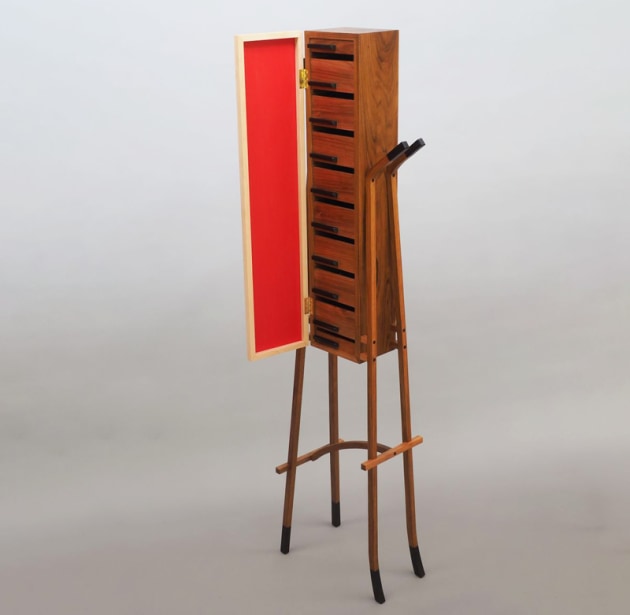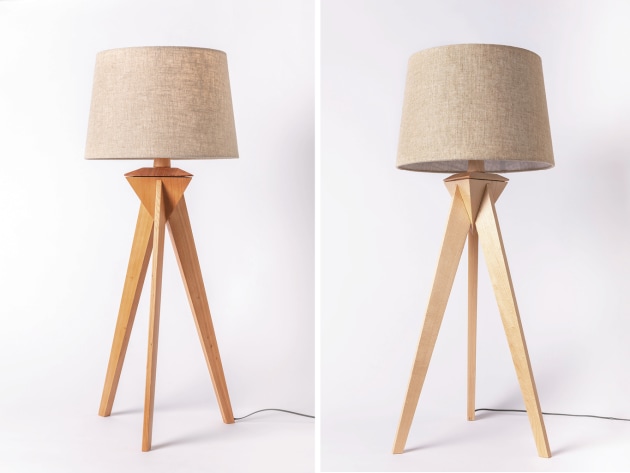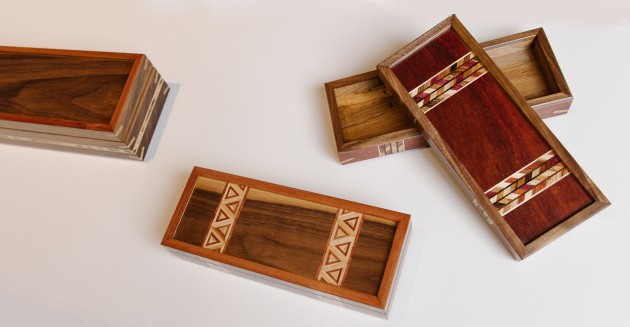Exhibition review: The Art of Making
Will Matthysen, Clock 204, 2021, Tasmanian myrtle, jarrah, sycamore, ebony, gold plated brass, steel, glass. Photo: Anna Hay
Words: Stuart Faulkner
A visit to the Studio Woodworkers Australia (SWA) website says the organisation is ‘a community celebrating fine craftsmanship’. Like any community, members are diverse in their specific interests, backgrounds and their chosen pathway under the umbrella term of ‘studio woodworker’.
Members range from those that have been honing their craft over many years, to members that are starting their own businesses, and oftentimes, finding their place in a new career. Some members create commission pieces, others have developed recognisable furniture ranges, some problem solve the technical aspects of bringing the designs of others to fruition, while still others like myself, focus on skill sharing through teaching. Sometimes it’s a mix of all of the available options, depending on time, place and opportunity.

Adrian Potter, Frida—Día de los Muerto, 2012, beefwood, white beech. Photo: Grant Hancock
A walk through SWA’s latest exhibition 'The Art of Making' at the Australian Design Centre in Sydney was a delight for the senses for anyone interested in fine woodworking. So many exceptional works in one place requires careful and quiet contemplation. While online viewing was available, it didn’t prepare me for seeing the pieces first hand, in particular Adrian Potter’s side table Frida—Día de los Muertos. This is a piece I have long admired for its expression of individual creativity as much as its cohesive design and level of execution.

Stuart Faulkner, Totem stools, 2021, walnut white oak, ebonised blackwood, blue oil, white grain filler, natural oil, mineral paint. Photo: John Rintoul
Many of the known and celebrated makers in this exhibition have lengthy and successful careers, creating a visual language that is the hallmark of each, and a recognisable commitment to their artistry. I’m thinking of Tony Kenway’s iconic rocking chair, Will Matthysen’s intricate and elegant timepiece, Evan Dunstone’s sophisticated Mutawintji 1 hall table, Silvio Apponyi OAM’s realistic animal sculptures, Gray Hawke’s suite of table and chairs, and Grant Vaughan’s Split Form sculpture.

David Upfill-Brown, Gymea table. Photo: Anna Hay
Not so easy to recognise in my mind is David Upfill-Brown’s work. At first glance I would have been hard pressed to say which of the pieces in the exhibition were his. Two sentinel standard lamps (nothing standard about them!) and his occasional Gymea table with a curved and laminated under-structure that provides the support for a striking blackheart sassafras top, were a surprise and delight.
Jim Homann and David Mac Laren OAM, Celebration hall stand, 2021, red mallee burl, red coolibah burl, American oak, ebonised American oak, stainless steel threaded rod, aluminium. Photo: Mahala Hill
A bold use of geometric forms and colour denotes the two sculptural hat stands Celebration and Exuberance by Jim Homann and David Mac Laren OAM. David is widely known as the owner of Bungendore Wood Works Gallery and for his support of makers. That support is further evidenced by his collaboration with three other makers in this show.

David Muston, Media Cabinet, 2021, celery top pine, birch plywood. Photo: Simon Whitbread
David Muston’s celery top Media Cabinet uses repeating slats with cut-outs as a core design element to integrate the functional aspects of the design, providing airflow through the vents and allowing devices to work effectively.
Nearby is Warwick Wright’s blackwood side table, a representation of line, taper and angles that results in an appealing and purposeful variation of a traditional leg and rail.
Also linear in nature is Mitchell MacNamara-Rice’s bookcase that uses wedged sections to give strength to the piece while conveying an impression of lightness and floating shelves.
Rhys Jones, two views of Machines for Thinking, 2021, rock maple, fibreglass, rattan cane. Photo: Stuart Hay
Another piece that is a study in lightness, although curvaceous in line, is Rhys Jones’s chair that resulted from a university brief ‘Machines for Thinking’. Rhys’s chair embodies his ideas of pushing timber to (almost) its breaking point. ‘How much material can be removed while maintaining strength and stability?’, he asks.
Like all woodworkers visiting an exhibition, I’m interested in construction, so it was interesting to hear Rhys say he added fibreglass to the laminations to strengthen the joint where the forces are greatest. In his words, ‘those laminations weren’t going anywhere!’.
Rolf Barfoed, Telecom hall table, 2022, brushbox, brass. Photo: Claire Williams
Echoing Rhys’s sentiments perhaps, that less is more, is Rolf Barfoed’s hall table Telecom. This piece continues earlier work in his Exo series that pairs minimalist design with astute making. There is a smooth, almost seamless transition between tabletop and leg that I didn’t fully appreciate until I saw an image of the componentry.
Like Rolf’s table, woodworkers will enjoy the reveal of the technical challenges that resolved the joinery in Thirston Morris’s mirrors. Think curved tapering lap joints, each one unique. To hand cut the joints is to invite some kind of madness so Thirston used his CNC to meet the challenges, the technology enabling him to accurately achieve the desired outcome, although still no easy task.
Wine and Whiskey wall hung cabinet, 2022. Photo: Anna Hay
Now I’m no whiskey drinker but understand there are nuances that require the valued dram to have special accoutrements and its own residence. Using Australian timbers, Raf Nathan’s wall hung cabinet perfectly fits the bill and conveys a sense of expectation, mellowness and richness within.
Phoebe Everill, Drummond bedside side tables. Photo: Anna Hay
Showcasing storm fallen timber, Phoebe Everill’s Drummond Bedside Tables cleverly use side hung drawers that extend the runners into drawer pulls. The choice of design allows maximum use of the available space.
Christopher Neal, Pyramid Display Case with Drawer (detail), Tasmanian blackwood, wenge, ebony, 2021. Photo: Mahala Hill
Christopher Neal has taken the traditional rectangle into a triangle in his Pyramid display cabinets and uses the Lamello system to discreetly make the connections required to add strength without bulk to his pieces.
Darren Oates, Parabolae hall table. Photo: Darren Oates
Darren Oates presented his signature Parabolae hall table in this exhibition, an example of enduring design and self-sustaining craft practice that also combines teaching timber bending techniques at the Sturt School for Wood.
Ruth Thompson, Daddy Long Legs, Dancelines Series. Photo: Peter Thompson
Ruth Thompson created the fourth cabinet in her Dancelines Collection. Ruth explained in her artist talk how accent details like colour and the ebony piano keys used for drawer pulls tell the story of dancer Fred Astaire in the piece she aptly calls Daddy Long Legs.
Warwick Jones, The Sullivan Whiskey Cabinet, 2021, Tasmanian blackwood, treated bronze wire mesh, ebony. Photo: Carmen Glenn
Warwick Jones’s Halo Light (above) takes pride of place above the signage advertising the exhibition and is remarkable for its scale and clean lines. A commanding piece that achieves presence without dominating, Warwick laminated strips of blackwood to create the curvature required for the form.
Positioned below Warwick’s light is Andrew Pinnock’s Oak Cricket Table that combines traditional knuckle joinery in the rails with a round top, rounds for the internal legs with a flat on the external leg faces.
Kanun Onsel, Angelic Sculptural Vases. Photo: Anna Hay
Smaller objects like Kanun Onsel’s Angelic Sculptural Vases offer a refreshing use of material and finish that I assume is a trade secret like the Colonel’s recipe, while Benjamin Reddan’s yosegi inspired boxes attest to his skills with inlay and veneer work. The Half Half planter and Little Deuce cars by Darren Naftal were an opportunity to present limited edition quality gifts and luxury homewares to a new audience.
Sebastian Wood, Walnut Table. Photo: Sebastian Wood
SWA encourages its members to share their knowledge through mentoring, so I was pleased to partner with Sebastian Wood in another exhibition. Not unlike an iceberg, two thirds of the beauty of Sebastian’s walnut side table lies beneath the surface. It is a study in curves, arcs and circles that are accentuated by the use of round over and tapered coved profiles. The careful use of spacers creates a shadow line between top and legs, and wedged tenons with radiused ends enhance the overall design.
Warwick Wright, Artimus lights in King Billy pine and rock maple. Photos: Julianna Griffiths
Collectively presented, the works by members of Studio Woodworkers Australia communicate a reverence for a precious resource. Each board of timber selected with care, each component evaluated, every detail refined. The culmination is a three-dimensional statement of intention, a desire to preserve craft while transforming ideas into treasured pieces. In 'The Art of Making' I think we can all celebrate the artist within.
Benjamin Reddan, Keepsake Boxes. Photo: Anna Hay
'The Art of Making' was displayed at Australian Design Centre in Darlinghurst, Sydney from February 10 to March 15, 2022. Learn more about Studio Woodworkers Australia at https://studiowoodworkers.org.au.
Stuart Faulkner is a furniture designer maker and woodwork teacher in Moss Vale, NSW, see http://heartwoodcreative.com.au




